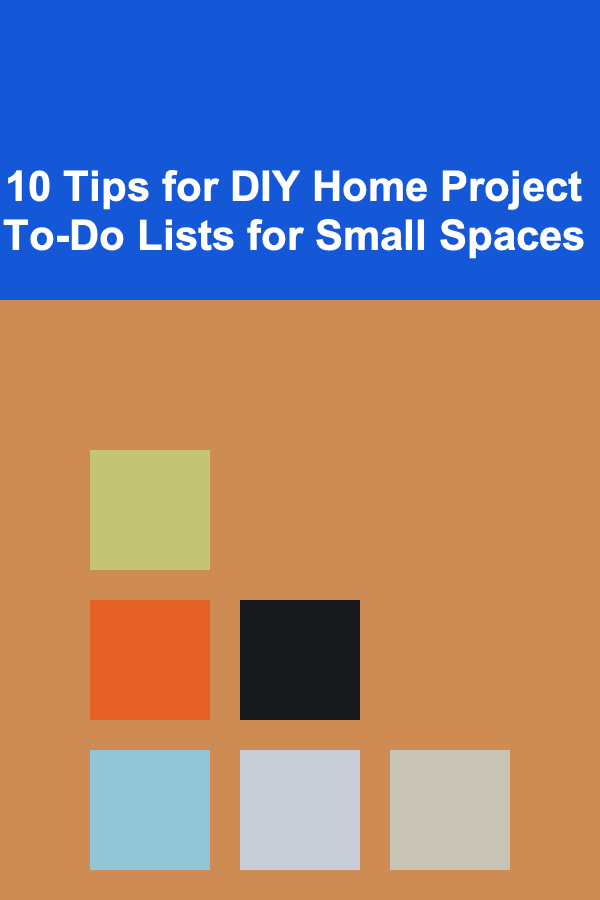
10 Tips for DIY Home Project To-Do Lists for Small Spaces
ebook include PDF & Audio bundle (Micro Guide)
$12.99$6.99
Limited Time Offer! Order within the next:

Creating and organizing a DIY home project in a small space is an exciting challenge that allows you to maximize the functionality and aesthetics of your home. Whether you're working with a studio apartment, a small one-bedroom, or even a compact house, effective planning and organizing can help you make the most of the space you have. A to-do list is one of the most powerful tools in this process. It helps you stay focused, organized, and ensures that each task is completed efficiently.
In this article, we'll explore 10 essential tips for creating a DIY home project to-do list for small spaces, to help you turn your ideas into reality without feeling overwhelmed by the limitations of a compact environment.
Assess Your Space Before You Start
The first and most crucial step in any DIY project for small spaces is to understand the limitations and opportunities your space offers. This means assessing your space for both the practical and aesthetic elements, identifying areas that need improvement, and considering how each element can enhance the overall flow of the space.
- Measure Your Space: Take accurate measurements of the rooms or areas you're working on. Pay attention to not just the floor space but also the height, as vertical space is often underutilized in small areas.
- Understand Flow and Function: Consider how people move through the space. Prioritize areas that will make the most impact on comfort and functionality.
- Analyze Lighting and Ventilation: Proper lighting and airflow can transform the feel of a small space. This should be factored into your planning.
Once you've assessed the space, you'll have a clearer idea of the limitations and the design possibilities, which will guide the rest of your DIY project.
Set Clear and Specific Goals
Before diving into any project, set clear and specific goals. For small spaces, the objective is often to maximize functionality without overcrowding. This will ensure that you don't just add decoration or furniture for the sake of it but create a space that serves your needs.
- Define Purpose: Are you trying to increase storage, improve aesthetics, or enhance comfort? Know what you want to achieve before starting.
- Break It Down into Smaller Tasks: For large projects, break them down into smaller, manageable tasks. For example, instead of just "remodel kitchen," break it into tasks like "install shelving" or "paint the cabinets."
- Prioritize: If you have multiple goals, prioritize them based on their impact. For instance, maximizing storage in a small bedroom might take priority over a decorative overhaul.
Setting clear goals will help you stay focused, and you'll be able to track your progress more efficiently.
Use Multi-Functional Furniture
One of the key principles in maximizing space in small areas is to make use of multi-functional furniture. Not only will this save space, but it will also make your home feel more organized and efficient.
- Foldable or Stackable Furniture: Items like foldable tables, chairs, and storage boxes can be tucked away when not in use, saving valuable floor space.
- Convertible Furniture: Look for furniture that can serve more than one purpose. For example, a sofa that turns into a bed, or an ottoman that doubles as a storage unit.
- Floating Furniture: Consider wall-mounted desks, shelves, and other furniture that helps free up floor space, making the room feel larger.
When creating your to-do list, make sure to allocate time to research and purchase these types of furniture.
Maximize Vertical Space
In small spaces, the floor area is limited, so it's important to use your vertical space effectively. By adding shelves, hooks, and even wall-mounted storage, you can store items without using valuable floor space.
- Shelves: Wall-mounted shelves can store books, plants, and decorative objects. Consider open shelving for an airy look or enclosed units to keep things tidy.
- Hanging Storage: Hooks and racks for coats, bags, and accessories can free up closet space while also acting as decorative elements.
- Tall Furniture: Opt for tall, narrow furniture pieces like bookshelves or cabinets that make use of vertical space.
Be sure to include the installation of vertical storage in your to-do list as one of the key tasks.
Plan for Smart Storage Solutions
Storage can be one of the biggest challenges in small spaces. The key is to make use of every nook and cranny. Think beyond traditional closets and cabinets and explore creative storage solutions.
- Under-Bed Storage: Use the space under your bed for drawers or bins to store seasonal clothing, shoes, or extra linens.
- Overhead Storage: Install overhead racks in closets or entryways to store less frequently used items like luggage or holiday decorations.
- Built-in Storage: For a more permanent solution, consider installing built-in storage units, such as cabinets or benches with hidden compartments.
Including tasks related to installing storage solutions on your to-do list will help you stay organized and maximize your available space.
Use Light Colors to Create the Illusion of Space
Color plays a crucial role in how spacious a room feels. In small spaces, light colors can help create the illusion of more space by reflecting light and making the area feel airy and open.
- Neutral and Light Shades: Opt for whites, light grays, or soft pastels to open up the space. These colors tend to make rooms feel larger and more inviting.
- Accent Walls: If you want to add personality, use a darker or more vibrant color on one wall while keeping the other walls neutral.
- Light Flooring: Light-colored floors, whether hardwood or tiles, can help enhance the spacious feel of a room.
This task should be included in your to-do list under "painting" or "wall treatments."
Incorporate Mirrors and Reflective Surfaces
Mirrors are a classic trick for making a small space look larger. By reflecting light and giving the illusion of depth, mirrors can help make a small room feel more open and airy.
- Full-Length Mirrors: Placing full-length mirrors on walls or behind furniture can make rooms feel more expansive.
- Reflective Furniture and Decor: Consider furniture with glass or metallic surfaces that reflect light and create a sense of space.
- Mirrored Accents: Small mirrored decor pieces, such as trays or picture frames, can subtly contribute to the reflective effect.
Make sure to add mirror placement and decor to your to-do list under the "decor" section.
Focus on Functional Decor
Decorating a small space is all about finding the balance between style and practicality. Every item you choose should serve a functional purpose or enhance the overall atmosphere of the room.
- Modular Decor: Use decor that can be easily moved or adapted to different configurations. For example, a modular sofa that can be rearranged or a rug that can be rolled up for cleaning.
- Decor with Storage: Look for decorative pieces that serve as storage solutions, such as decorative baskets, storage ottomans, or stylish shelving units.
- Minimalist Approach: Avoid overcrowding your space with too many decorative items. Instead, choose a few high-impact pieces that complement the room's functionality.
This type of planning will help ensure that the decor contributes positively to the overall space.
Create Zones in Open Plan Spaces
If your small space is an open-plan area, creating distinct zones for different activities is crucial to maintaining order and maximizing the use of space. By dividing the area into smaller zones, you can make it feel more organized and purposeful.
- Use Furniture to Define Spaces: Place furniture like bookshelves, sofas, or rugs to define separate zones for sleeping, dining, and relaxing.
- Visual Separation: Use curtains or sliding panels to divide areas without completely closing them off. This gives flexibility while maintaining a sense of openness.
- Multi-Functional Zones: In a small space, it's important that each zone serves multiple functions. For example, a dining table that doubles as a workspace.
Consider incorporating these zonal plans into your to-do list to guide your design and layout decisions.
Stay Organized and Keep It Simple
Finally, simplicity and organization are key in small spaces. Clutter can make even the most thoughtfully designed space feel cramped. To maintain productivity and aesthetic appeal, keep your space organized and avoid over-decorating.
- Declutter Regularly: Get rid of unnecessary items and only keep what you truly need or love. Regularly reassess and donate or sell items you no longer use.
- Use Smart Storage: Make use of the storage solutions you've implemented, ensuring everything has a designated place.
- Keep It Simple: A minimalist approach to decor and furniture allows the room to feel more open and functional.
The last task on your to-do list should be a regular routine for organization and decluttering.
Conclusion
A DIY home project for a small space can be incredibly rewarding. By following these 10 tips, you can create a well-thought-out to-do list that helps you maximize every inch of your home. The key is to blend functionality with style, using smart storage solutions, multi-functional furniture, and clever design tricks to transform your small space into a practical and beautiful living area. Whether you're tackling a single room or an entire home, these steps will ensure that your DIY projects are well-organized and successful.
Reading More From Our Other Websites
- [Organization Tip 101] How to Organize Sports Equipment by Sport for Faster Access
- [Organization Tip 101] How to Use Vacuum-Sealed Bags for Fabric Storage
- [Home Renovating 101] How to Increase Curb Appeal with Strategic Landscaping for Your Home Renovation
- [Home Holiday Decoration 101] How to Decorate for the Holidays in a Small Apartment Without Overdoing It
- [Personal Investment 101] Building AI Models for Profit: How to Monetize Your Deep Learning Skills
- [Personal Investment 101] Exploring the Intersection of Deep Learning and Passive Income Opportunities
- [Home Renovating 101] How to Refurbish and Refinish Furniture for a Fresh Look
- [Organization Tip 101] How to Create a Functional Layout for Volunteer Spaces
- [Personal Care Tips 101] How to Use Hair Mousse for a Natural-Looking Texture
- [Home Space Saving 101] How to Make the Most of Your Small Entryway

How to Choose the Right Bunning Carpet Cleaner for Your Needs
Read More
How to Design a Functional Entryway for Seasonal Changes
Read More
The Art of Financial Analysis: Best Practices for Interpreting Financial Data
Read More
How To Build Positive Self-Talk
Read More
Mastering Freestyle Rollerblading: A Comprehensive Guide
Read More
How to Use a Monthly Planner for Meal Prep Success
Read MoreOther Products

How to Choose the Right Bunning Carpet Cleaner for Your Needs
Read More
How to Design a Functional Entryway for Seasonal Changes
Read More
The Art of Financial Analysis: Best Practices for Interpreting Financial Data
Read More
How To Build Positive Self-Talk
Read More
Mastering Freestyle Rollerblading: A Comprehensive Guide
Read More